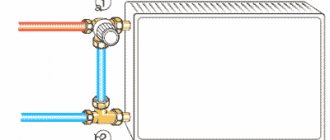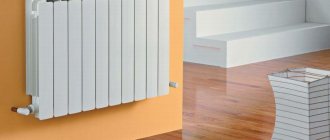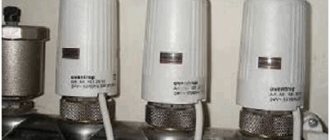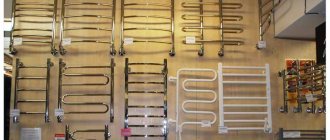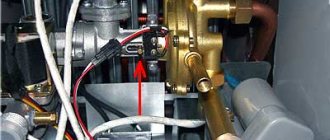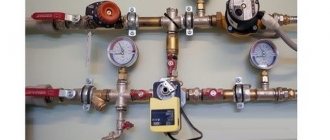All domestic bathrooms are equipped with a heated towel rail. After all, he has such a role! Entering almost any bathroom of our compatriots, you can see things drying on it after a little “washing”, children’s mittens dangling after a winter party and much more. But the main functionality of this device is to heat the room and maintain a dry climate in a humid environment. And its failure means not only the loss of a place for drying, but the appearance of dampness in the bathroom and its attendant troubles: fungus and mold. These factors lead to damage to the finish and make staying in the bathroom uncomfortable. If the dryer is made of steel, as in most cases, then as it cools down, corrosion processes begin. This is already fraught with depressurization of the pipe and flooding of the home. What to do if the heated towel rail stops heating? How to deal with this problem? What factors lead to equipment losing its operational properties? Let's look further.
What you need to know when choosing a heated towel rail
Shapes of heated towel rails: a - m-shaped; b - U-shaped; c - f-shaped; g - “snake”; d - “ladder”.
Manufacturers of sanitary equipment use mainly two materials in the manufacture of heated towel rails - stainless steel and brass coated with a layer of chrome. At first glance they look exactly the same. All of their differences lie in their different ability to withstand operating pressure differences inherent in the supply of heat and hot water to multi-storey buildings.
Steel products are more durable than those made of chrome-plated brass, therefore, in multi-storey buildings, steel is mainly used, since in heat supply and hot water supply systems pressure drops sometimes reach 8-10 atm.
When choosing a steel heated towel rail, you should choose products made from seamless pipe, the thickness of which must be at least 3 mm. The absence of a welded seam on the pipe guarantees that there will be no leaks that are possible during the operation of a product made from a welded pipe.
Domestic manufacturers practically do not produce brass heated towel rails. The plumbing products market offers imported products, which are mainly used in low-rise, private construction when equipping houses with an autonomous heating system.
Of course, imported brass plumbing has a more varied shape and is more attractive in appearance, but it is designed for much less pressure than sometimes occurs in the pipelines of multi-story buildings. Therefore, they are purchased for installation in cottages, country houses and country houses, where an autonomous system with an operating pressure of about 3 atm is installed.
When choosing a heated towel rail, you must take into account an important feature of its design - the product you like must have a valve through which you can bleed air if necessary. Such a valve is manufactured by domestic manufacturers under the name “Mayevsky tap”. With its help, the problem of first starting up a heated towel rail after its installation or after connecting the system to the water supply after a maintenance break is easily solved.
Design of the “Maevsky crane” and its correct installation
Installation of a heated towel rail to the wall (diagram).
Many people who are not very knowledgeable in technology, hearing the name “Maevsky faucet”, imagine that this is a very complex piece of plumbing equipment, and some do not even know what it is needed for. In fact, there is nothing complicated in its design; the simplest “Maevsky tap” includes only two parts - a body and a conical screw.
At its core, this design is a reliable air outlet. The principle of its operation is as follows: when the tap is open, air from the heating system enters its body through the inlet, and at the same time is removed through the outlet located in its side. When closed, the screw fits tightly to the inside of the housing, preventing liquid from escaping from the pipeline.
“Maevsky tap” is available in different sizes with external thread diameters corresponding to the diameters of pipes used for the manufacture of heating systems. Depending on the design, the devices can be opened either by hand or using a screwdriver or a special key.
Before you begin installing a bathroom heating device, you should take care of purchasing:
- “Maevsky tap”, if it is not included in the heating device kit;
- ball valve (3 pieces);
- a screwdriver or a special key for the faucet;
- containers for collecting water.
Since the heated towel rail must be installed by a master, he will have everything else necessary for the job.
System clogging and breakdowns - mechanical defects
Sometimes the cause of device failure is mechanical faults, for example, breakdown of shut-off valves. Ball valves, although made of durable and strong metal, can break and crack over time. In this case, there is only one way out - replacing the faulty equipment. It is very difficult to change ball valves yourself; it is much easier to contact a plumber who will do all the work quickly and efficiently.
A heated towel rail can also become cold due to clogging of the entire system. This phenomenon is typical for houses with low quality water, which contains large quantities of salts and metal impurities. As a result, build-up and contaminants form, which reduces the coolant pressure in the device.
Installation of a heated towel rail
If replacing the components of a heated towel rail is quite problematic, then cleaning the system is much easier. It is necessary to ensure the availability of special chemicals that are poured into the unit itself. After a certain time, the chemical mixture is completely removed. All that remains is to carefully clean the pipe cavities using a metal brush or wire, as well as a stream of water under enormous pressure.
Causes, troubleshooting methods
So, your heated towel rail remains cold, there is no necessary heat from it. And why is this happening? Why is the dryer cold? This could be an air lock with excess air in the heated towel rail, or failure of the entire device. Let's try to understand the main reasons, and also find out how this or another malfunction can be eliminated.
https://youtube.com/watch?v=c7scEb7HLQI
There is no hot water in the system. If you use a dead-end system, where water is supplied only when the tap is opened, then it’s hardly worth bothering with your dryer. Here the water option is unlikely to be relevant anymore. Change it to electric. Here is the entire solution to the problem.
Traffic jams and blockages. Many people installed their heated towel rail a long time ago, but they do not know that it should be cleaned periodically. It’s no longer enough to simply bleed air. You will need to first close the tap and then remove the device. It would be correct to put special plugs on the pipes. Arm yourself with a soft wire with a brush at the end, with which you can clean scale, blockages, and plugs from the walls. After cleaning, be sure to flush the system. And not just water, but a solution of hydrochloric acid. Pour it into the system and wait a while. After that, drain. Due to the work of hydrochloric acid, the sediment will become softer and easier to remove. Unfortunately, even after this, the dryer may remain cold. You tried to ventilate the device, the detected plug was removed, but it still does not heat. This happens due to the age of the heated towel rail or not very good quality. Therefore, there is only one solution to the problem - replacement. Incorrect installation. In some situations, dryers were installed recently, but they still do not heat. Due to inexperience, many home craftsmen install it far from the water riser. Due to the resistance that arises, hot water simply cannot enter the dryer pipes. Of course, the way out of this situation is to remove the device and install it in the correct place. Old pipes. Unfortunately, pipes can only survive for a short period of time. As a result, the hot water supply system pipeline becomes clogged and clogged. As a result, we are dealing with low water pressure. Because of this, the dryer does not work well.
To clean the pipe, you must first close the tap and plug the hot water supply system. On the circulation line, the plugs are screwed in, after which the tap is opened. Sludge and water should flow down the drain. If hot water does not flow through it, it means that the supply is clogged, or the problem is in the dryer itself. Clean the system using the same method as above. Then put everything back in place and open the taps. If it doesn't heat up, you'll have to change it. Cork. Often it is the air lock that causes there to be no circulation and the water heated towel rail does not heat the room. The presence of air in the heated towel rail is easily eliminated if the device has a special Mayevsky tap
It is very important to consider its availability when purchasing a dryer. And you can earn money on it in Slovakia through https://ivs-llp.kz/rabota-v-slovakii. Unfortunately, air locks are one of the most common occurrences when problems arise with water types of heated towel rails
Resumption of circulation is carried out by simply bleeding excess air from the system. After this, the device will start working again.
https://youtube.com/watch?v=V2OBwjAUTRQ
As you may have noticed, the reasons why the heated towel rail does not heat can be very diverse. One way or another, most of them can be corrected without even resorting to the services of specialists. The most important thing is to correctly identify the malfunction and act carefully when removing equipment, cleaning it, washing it, and so on. Follow safety rules and put your dryer in order.
We eliminate the causes of ineffective work
Although a heated towel rail is a fairly simple device, finding the reason for ineffective operation can be difficult. To reduce time and not do unnecessary work, the search for the “weak link” is carried out according to a certain algorithm:
- de-air the heating device;
- determine the hot water pressure at the inlet to the heated towel rail. This can be done either with a special device - a pressure gauge, or using one of the calculation methods;
- analyze and eliminate the causes that lead to a drop in pressure in the circuit;
- the heated towel rail is dismantled and cleaned of dirt and deposits.
If the heated towel rail does not heat up at normal pressure in the DHW system and there is good flow through the circuit, it means it is installed incorrectly. In this case, it is necessary to change the connection diagram, and possibly move the device to another location. We'll move on to a look at installation errors and how to fix them a little later. Now let's remember the simplest methods for solving the problem.
How to remove air locks
You can check whether an air lock is the cause of the trouble and remove it from the heated towel rail using a special air vent, which is also called a radiator air valve or Mayevsky tap. To do this, the valve locking screw (needle) is turned out of the seat so much that air begins to hiss out of the radiator.
The process of removing an air lock using a Mayevsky tap does not cause any difficulties - any home craftsman can handle this procedure
You can determine the end of the process by a thin stream of water without bubbles or hissing, which will begin to flow out of the valve hole. After this, Mayevsky’s tap is turned off and checked to see if the coil has begun to heat up.
If the heated towel rail is built into an individual heating system, de-aeration of one device is not enough - a comprehensive removal of air from the entire system will be required, starting from the boiler and ending with the radiator in each room. In systems with forced circulation of coolant, it is better to turn off the pumps - this prevents the movement of air pockets and facilitates their complete removal.
Often our readers are faced with a situation where the heated towel rail was initially installed without an air vent. In this case, we recommend installing this useful and inexpensive device - in the future it can save you a lot of time and effort.
The simplest design makes the Mayevsky crane reliable and easy to use
As a temporary measure, it is recommended to bleed the air by depressurizing the circuit. To do this, you need to stock up on some kind of container (a bowl or bucket), and lay a rag on the floor under the PS. Next, you should slightly unscrew the top nut, with which the “towel” is connected to the riser. At the same time, water mixed with air bubbles will begin to ooze from under the connection. After waiting until the hissing stops, the tightness of the system is restored.
Video: how to bleed air from a heated towel rail
How to get rid of blockages
In old “Stalin” and “Khrushchev” buildings, utility lines are so worn out that blockages and breaks due to rusty pipes are as common as air leaks. To remove the blockage, you need to turn off the water and disconnect the heated towel rail from the riser. At the same time, several liters of water remain in the coil, so it is better to place some empty bowl or bucket under it.
To determine in which part of the circuit the blockage is located, a hose with good water pressure is connected to one of the outlets of the heated towel rail, and the second is lowered into an empty container or bathtub. A decrease in water flow pressure indicates that the coil needs cleaning.
Oxalic acid is an excellent agent for removing scale, rust and calcium deposits
To remove internal deposits, both mechanical and chemical methods are used. In the first case, you can use a plumbing cable with a small homemade brush at the end. It is introduced inside and with translational and rotational movements the walls of the device are cleaned of scale and rust.
To clean the inner surface of the heated towel rail and heating and hot water system pipes, you can use a plumbing cable with a metal brush
In case of severe contamination and the presence of persistent deposits, you cannot do without special chemical reagents such as “Mole”, “Mr. Muscle”, “Brawler”, etc. Dissolved chemicals are poured into the device with the pipes installed upward and kept for the time indicated on the packaging.
Along with household chemicals, folk remedies can also be used to clean heated towel rails. For example, a good result is obtained by combining a solution of acetic acid and regular baking soda poured into a heating device.
The most stubborn deposits of rust and scale can be removed by dry cleaning using a hydrodynamic method
In cases where a drop in pressure occurs due to old, clogged pipes, you can try to restore their permeability using a plumbing cable. If this option does not give the expected result, then one of the companies that provides hydraulic pipe cleaning services (using high-pressure units) can be involved in solving the problem.
What to do if circulation in the DHW circuit is disrupted for subjective reasons
When looking for the reasons that lead to a decrease in pressure, the human factor cannot be discounted. Most often, the heated towel rail is connected to the return line of the hot water supply with constant circulation, thanks to which it is possible to maintain the temperature of the hot water within the specified limits. In order to ensure equal thermal conditions for each consumer, all outlets from the riser are equipped with bypasses. It is thanks to these simple sections of the pipeline that it is possible to avoid a significant difference in the temperature of the hot water between the first and last points.
Installing taps and plugs on the bypass is prohibited, as it changes the hydrodynamic characteristics of the hot water system
In order to increase the temperature of the substation in a separate apartment, it is enough to close the bypass using a ball valve - in this case, the entire flow of hot water will go through the heating device. The result of such “innovations” is a drop in temperature and an increase in the hydraulic resistance of the system. You can guess for yourself that several “innovators” living in your building are capable of leaving the bathrooms of all other apartments without heat. That is why carrying out work that can change the hydrodynamic parameters of the hot water supply system is prohibited by law.
Another example of an irresponsible attitude towards communal communications is the removal of a heated towel rail created by bending the riser without restoring the integrity of the latter. In other words, during the renovation, one of the neighbors cut out the unaesthetic structure and installed plugs at the ends of the pipes. In this case, bypassing this apartment, it is necessary to install a jumper from the same pipe that made the riser.
Installation of shut-off valves on the riser is prohibited not only to avoid interference by residents in the operation of the hot water supply system, but also due to the increase in hydraulic resistance of the main line
According to sanitary standards, it is possible to turn off the hot water supply only in case of repairs or maintenance work, so substations must be heated in any season. In reality, with the end of the heating season, the housing office often turns off the return branch in the DHW circuit, transforming the circulation connection circuit into a dead-end one. In this case, the heating device will only work when the “hot” tap is opened.
If you are confident in the correct installation and serviceability of communications, you should talk to your neighbors or file a complaint with the management company. If this does not help, then you have two options to solve the problem. The first is to become the same offender by reconnecting to the DHW supply branch, shutting off the bypass or installing an additional circulation pump. The second is to remain a law-abiding citizen, power the device from the heating system or install an electric (combined) device.
Modern electric heated towel rails are equipped with thermostats that allow you to regulate the temperature of the device over a wide range
Correcting installation errors
All the methods described above for restoring the functionality of a heated towel rail are quite simple even for people who have picked up an adjustable wrench for the first time. Much more difficult is the situation with the heated towel rail, which was installed in violation of the laws of thermodynamics.
One of the most common mistakes is a lateral or bottom connection, in which the heating device (in whole or in part) is installed below the point where the return line inserts into the riser. In this case, gravitational forces are not enough to create the pressure necessary to lift the cooled coolant layers to the level of the return pipeline. Of course, natural circulation will not work in this case.
An error in installing the return line above the bottom point of the heated towel rail makes circulation of the coolant impossible
Often, for the sake of convenience and aesthetics, careless craftsmen connect a heated towel rail, hiding the supply pipeline behind the suspended ceiling, and lay the return line under the floor. The “loop” located in the supply area is an excellent trap for air bubbles - a plug formed in this place will most likely block the path of water flow. As for the lower “loop,” it prevents the cooled coolant from being pushed out for the reasons already discussed above.
Attempts to hide the heated towel rail connections in the floor or behind the ceiling lead to the formation of “loops” that impede or completely stop the circulation of hot water
If the connection diagram includes an offset or narrowed bypass, then with a lower supply of coolant, the forced circulation pressure can be equalized with the efforts of the “gravity pump”. In most cases this does not happen because the pump “wins”. And, nevertheless, stopping the flow of hot water can be caused either by lengthening the connecting lines and reducing their cross-section, or by installing a bypass tap by one of your neighbors.
A circuit with a narrowed or offset bypass is best used with an upper coolant supply
To correct the situation, a complete or partial change in the connection diagram is necessary. You may even need to move the “towel” to a new place. If such measures do not suit you, then you can correct the situation by installing a circulation pump in the circuit. The only thing you need for this is to find out from specialists from the housing office the direction of movement of the coolant in the riser.
Read about all the features of moving a heated towel rail to another location here:
In all other cases, you should take into account the recommendations of experienced plumbers. So, for all cases of lateral connection (including diagonal), the following conditions will need to be met:
- the upper outlet of the heated towel rail should be below the outlet of the riser, and the lower pipe - above the entry point of the return line;
- there should be no “loops” on the highway;
- the cross-section of the pipeline must take into account the hydraulic resistance of the coil;
- if the upper crossbar of the PS is located above the hot water sampling point, then the heating device must be equipped with a Mayevsky tap.
If all the necessary conditions are met, then no bends in the connecting pipeline can interfere with the normal operation of the design radiator
With a lower connection, the following will help correct the situation:
- moving or changing the bypass cross-section;
- compliance with the required slopes and removal of “loops” from the diagram;
- ensuring the condition that the corresponding riser outlets will be located below the connection points of the “towel”.
When considering the bottom connection diagram, you should definitely analyze the direction of water flow when it is cooled in the coil and determine whether it will circulate with the top or bottom supply.
The erroneous opinion that without installing a narrowed bypass, water will not circulate through the device’s coil leads to unjustified installation of bypass sections with a reduced flow area. But in a circuit with a lower coolant supply and weak circulation, such a narrowing can precisely be the reason why the coil remains cold. The cross-section of the bypass section should not be reduced by more than one step, and in the case of a displaced bypass, this is not recommended at all.
If the heated towel rail does not heat with a lateral or diagonal connection and an offset or narrowed bypass is used, then you should check the direction of movement of hot water in the riser. As noted above, with lower supply such schemes are inoperative due to the fact that the circulation of the coolant is hampered by the operation of the “gravity pump”.
You will receive more information about the methods of installing heated towel rails and installation technology by reading this article:
Causes and troubleshooting of water heated towel rails
Water heated towel rails are very popular today. Many people choose them, refusing to buy electrical devices. The fact is that water dryers are more common in our country. Almost every user is familiar with them. Various problems that arise with such products can be solved on your own. Let's take a closer look at how you can independently repair a water heated towel rail in different cases.
Low heating temperature
Low heating temperature can be due to various reasons. Often the problem lies in the formation of a so-called air lock in the dryer. If such a plug appears in the device, you will need to bleed off excess air until the water flows again
For these purposes, when buying a heated towel rail, you need to pay attention to the presence of a special air drain valve. Otherwise it is called the Mayevsky crane
If you have such a part at hand, then there will be no unnecessary difficulties in solving the problem that has arisen. You just need to open this tap and then wait for the water to appear.
If the heated towel rail heats very poorly compared to the rest of the system, then the reason may be that the conductive line is clogged or a lot of scale has appeared on the walls of the pipe. To fix these problems, you will have to resort to dismantling and cleaning the device.
Leakage
Leaking is a common problem that occurs for various reasons. Often such consequences result from wear of the gasket. In this case, it will need to be replaced with a new one. When making the necessary replacement, you should use special fluoroplastic gaskets, which are more durable and reliable. If you have a rotary dryer, you should not overload it. It’s better to install a couple of auxiliary hooks than to call plumbers.
If the source of the leak is observed in the body of the dryer, then this malfunction will be much more serious. It is unlikely that you will be able to solve this problem yourself, so it is advisable to turn to the services of specialists. The main pipe may also leak. This often occurs due to a lack of power in the water dryer itself during pressing. If the unit leaks because of this, then it makes sense to call specialists.
Complete absence of heating
In some cases, a problem may arise due to the complete lack of heating of the water heated towel rail. Most often, the cause of this problem is a shutdown of hot water in the general system.
Ladder heated towel rail does not heat up
If you do not have knowledge in heating engineering and hydraulics, then it is better not to try to repair an old one or install a new water heater yourself, but to entrust it to experts.
However, more often than not, the owner of the apartment himself undertakes repairs and installation, and for advice, as a rule, he turns to forums on the Internet:
“...Nikolai from Moscow asks you to tell me why the ladder dryer that he installed with his own hands does not heat the towel. Situation: I decided to replace the U-shaped dryer in the bathroom with a new one, like a ladder. I did as the experts advised. I'm checking. Opened the valve. The water began to gurgle. There are no leaks. First it warmed up. An hour later it's cold. I thought there was an air lock. Mayevsky opened the tap. I let out half a bucket of water while it was hot. The pipes got hot. 2 hours passed and everything cooled down again. Now I don't know what to do. Please, someone help. I sent a photo of the assembly.
Answered by Sergey from Irkutsk: The photo shows that it was not assembled correctly. A bypass is installed with a diameter equal to the main riser. This means that the pressure in the main pipe is higher or equal to that in the P\S. The coil pipe is thinner than the diameter of the hot water pipe. Boiling water enters the ladder, but cannot get out, there is not enough strength, so it quickly cools down.
On the bypass, you need to reduce the diameter of the pipe. At the upper point of entry into the PS, the pressure will rise. Water circulation will be restored. Your dryer will get hot.
It is prohibited to install the valve tap on the bypass.
Another option: close the shut-off valve on the hot water supply, thereby reducing the pressure in the riser and the heated towel rail will definitely heat up. However, on the upper floors the pressure will decrease. Right. Max confirms: according to the laws of physics, liquid moves along the path of least resistance. In the P/C pipe the pressure is lower, and in the DHW riser it is higher. There is an obstacle at the exit. The movement stops. The water is cooling."
Installation features: how to start a heated towel rail
Before installing a heated towel rail, you first need to select it. For apartments, it is recommended to choose devices from a domestic manufacturer that will comply with certain GOSTs, since imported ones may not be suitable for our installation. But for private homes, foreign brands are also quite suitable.
It is also impossible to allow the pipes of the device to be smaller in diameter than the main system. If this happens, then you need to select and install the necessary adapters. For main connections it is best to use “American” ones. They will allow, if necessary, to easily and without problems remove the entire device. It is also recommended to install ball valves and special jumpers for convenience.
Installation of a heated towel rail:
- First of all, the device needs to be assembled: to do this, it is necessary to install shut-off valves on the supply line, which have detachable connections;
- Attach the assembled device to the wall;
- Bring pipes from the main riser.
Having completed all these steps, you can begin the initial launch of this device (heated towel rail). To start the device we need a pre-installed Mayevsky tap, which is usually located at the top of the device. Having opened the tap, you need to gradually fill the entire device with water so that it does not become airy, that is, air jams should not form. In order for the launch to take place correctly, you need to have enormous professional skills, and not just turn off the water.
How to tell if a device can be repaired
What to do if the heated towel rail in the bathroom does not work? Having determined the source of the problem, you will need to repair the device as soon as possible. But it is recommended to do this yourself only in situations where you have the appropriate knowledge and skills.
And if there are none, then you will need to urgently contact a specialist who will restore the operation of the device again by eliminating the malfunction.
In other cases, the consequences can be more than dire. Breakthroughs are possible, as a result of which your apartment will fill with hot water, and water will also begin to drip from the ceiling of your neighbors living below.
Correcting possible breakdowns with your own hands
Tool required:
- indicator screwdriver;
- Phillips screwdriver:
- pliers;
- adjustable wrench;
- tester;
- funnel.
To fix this:
- Remove the heated towel rail from the brackets and unscrew the plug with the Mayevsky valve and the gasket, which is located in the upper part.
- Turn over and drain the liquid into a container prepared for this purpose.
- Unscrew the connection of the heating element of the heated towel rail with the device (in the lower part), that is, in the place where the leak formed, using a key.
- Remove the old gasket and replace it with a new one.
Reference! The plumbing store asks for a seal made of fluorine-containing polymer and the appropriate diameter.
If the device does not heat
Check the entire electrical circuit. First, inspect the socket of the heated towel rail: insert a plug from another device into it. If it doesn't work, unscrew the socket.
First, the switch labeled “bathroom” is turned off on the electrical distribution panel. If there is no such inscription, turn off the general packet switch.
Important! The socket must be grounded and have an automatic shut-off system. It is recommended to install a waterproof socket
The problem with a faulty heated towel rail socket is solved in this way:
- The burnt-out contact of the heated towel rail is restored and reassembled.
- If this does not help, change the entire outlet to a waterproof one.
The next possible breakdown is a malfunction of the connection to the heated towel rail (cable with plug). Use a tester to check the continuity of the circuit by resistance to direct current. Sometimes it is possible to access the wire at the junction with the thermostat, sometimes this is not possible, because the cable is sealed.
If the tester shows no network, change the entire line or just the plug.
Photo 1. Checking the heating element of a heated towel rail using an electrical resistance tester. If the voltage is insufficient, the entire circuit must be checked.
Then, using a resistance tester, they check the integrity of the thermostat circuit - the heating element. Most likely, the breakdown is in this element.
Most companies provide the ability to replace heating elements, regardless of whether they are intended for wet or dry dryers.
Replacing the heating element
When purchasing a heating element, they also purchase gaskets for connection to the housing. The seller is asked to dispose of the old NE, if such a service is available.
Replacement steps
- An adapter is inserted into a nut with an internal thread, a gasket is placed inside, a ring is put on the protruding part of the adapter from below, and the pin is screwed into the ring with a screwdriver, securing the adapter immovable.
This design is put on the heating element. Carefully screw the nut with the heater into the heated towel rail and tighten it with a wrench.
- Install the entire set of “towels” in their original place. Place a funnel in the top hole and pour it into the coolant (oil, water, antifreeze) in small parts. Check the lower threaded connection for fluid leakage. If necessary, tighten with an adjustable wrench. Install a nut with an adapter, gasket and Mayevsky valve in the upper part.
- The upper part with the valve is wrapped with a rag to prevent the coolant from leaking onto the floor when the heater is connected.
- Turn the thermostat to maximum and wait: when heated, excess liquid will come out through the Mayevsky valve. Remove the rag, tighten the valve and screw on the cap that hides it.
When replacing a dry heating element, the procedure is simpler and does not require a detailed description.
Remove the plug and if the phase wire burns out at the junction with the heater, correct the breakdown, wrap it with heat shrink and put it in place. If the thermostat in the device fails, they replace it or try to connect it directly, without this device.
If the problem is a broken heating cable, the fix will require replacing the heating element.
Attention! Before installing a new heating cable with a thermostat in place, check it with a tester
Electric heated towel rails - is it difficult to replace heating elements?
Electrical appliances come in two main types - cable and those equipped with tubular electric heaters. If the cable heated towel rail is cold, then most likely it will not be possible to repair it; the only way out is to replace the equipment with another one. The situation is much simpler in the case of electric heaters. You should know that the heating element is located at the bottom of the equipment, so access to it is not limited in any way.
Electric heated towel rail
A heating element heated towel rail may not heat due to a lack of coolant, as well as due to natural wear and tear. Its design consists of the following elements:
- tubular heater;
- quartz sand located in a tube;
- spiral in the sand.
The spiral is necessary to heat the sand, which transfers thermal energy directly to the tube. This is how water is heated, while the coil is always in a cooled state. The lack of coolant causes the spiral to fail due to melting and overheating. In working condition, the heating element must always be in water. If there is a problem, you can purchase another heater and install it - this is a fairly quick and simple operation.
Third party connections
In the bathroom of an apartment building, the PS is the only heating device. It is in the bathroom that heated floors are most often used. Therefore, the water heating circuit is often connected to the hot water supply/heating riser via a tee.
The heated water-type floor is powered from the riser of the heated towel rail.
Initially, such additional heat consumption was not included in the building design. Therefore, a neighbor or owner several apartments down the riser may simply not be able to provide the required temperature of +60°C in the hot water supply line.
Illegal substation connection diagram.
Such actions are strictly prohibited by law. It is enough to contact the housing office with a complaint or notify the heating and hot water supplier (usually the same management company) about this, so that the violator is subject to fines. He will be obliged to return everything to its original form in court, and the deadlines for completion will be monitored.
For clarity, you can use the table:
| Malfunction | Elimination |
| air lock in PS | bleeding through the Mayevsky tap |
| air lock in the system | converting a horizontal line from a loop to a straight line |
| small inner diameter fittings | installation of tees, bends of larger diameter |
| narrowing of the internal hole when welding propylene pipes | re-soldering the circuit |
| mud plug | purge of pipes after switching off the substation |
| dead-end DHW riser | impossible to eliminate |
| end of the heating season |
The management company is obliged to ensure normal operation of the PS, that is, to fix the problem free of charge. However, the owner does not need to call the management company, but go there in person to submit an application. If there is no response to this request, you can complain about the management company to the State Housing Inspectorate.
Thus, the reasons for a cold heated towel rail can be incorrect assembly diagrams, installation errors, incorrect choice of diagrams and components, ignorance of the design of heating systems, DHW in an apartment building. To restore the functionality of the PS, you can contact the management company or troubleshoot the problems yourself
The main difficulty of the drying device
Residents of high-rise buildings can often encounter this problem when the centralized heating system is turned on in the autumn. At this time (when the pipes are filled with water), air may appear in the pipes. Similar plugs in most cases appear in the final parts of the heating system, which is what a heated towel rail is considered to be.
As soon as air appears in the pipes, the high-quality circulation of hot water is disrupted, so the dryer stops heating.
A long period of regular towel drying can significantly affect your habits and good quality ventilation of the bath, because a lot of moisture, even in seven days, can appear on the wall decoration of the room.
If you are going to install a towel dryer or have already installed it, you must be aware of all its methods and possible problems in solving them.
How to start?
Now let’s try to figure out how to eliminate the above-mentioned problems and get the heated towel rail into working condition. Let's start with a situation where an air plug has formed in the system. Removing the air can help here.
The easiest way to do this is in a private house, where the owner knows the structure of the water supply mechanism and where the tap is located, when opened, the air can be released. If the house is multi-story, then there is a high probability that it will be necessary to bleed the entire riser. The algorithm of actions will depend on the type of building, because the structure of the riser varies everywhere:
- In 5-story buildings built in Soviet times, the hot water riser goes to the last floor, after which it goes down again. Air accumulation usually occurs on the top floor at the highest point. And the descent should be made here. Usually in apartments on the top floors there is a special hose on the top tap of the riser. When you turn the valve, water flows out of the hose until the air cushion disappears.
- In 9-story panel-type buildings, all communications usually end in the attic, which is why all problems will be eliminated there. Considering that there is not always access there, you will have to call a plumber from the organization that services the house. If you have access, then you can do everything yourself. The procedure here will be the same as in the case of 5-story buildings.
- In other types of buildings, you should not engage in arbitrariness and you need to call a plumber who will carry out all the necessary actions.
If we talk about removing air directly from the heated towel rail, then there are 2 solutions. If the equipment is old, then the algorithm of actions will be as follows.
You should place a container under the equipment where the water will drain. This will prevent the room from flooding. Using an adjustable wrench, you need to unscrew the nut that connects the dryer to the hot water pipe
You need to be extremely careful not to strip the threads. This is especially important if the equipment is really old. You must wait until the hissing stops and water begins to pour into the container. Carefully tighten the nut.
If the heated towel rail model is relatively new, then everything will be much simpler, because it is equipped with a special air bleeder, which is called a Mayevsky tap. In essence, it is a shutter in the shape of a narrow, cone-shaped cylinder. Its components are a locking screw, as well as inlet and outlet openings, which are small in size.
To bleed air using such a device, you will need:
place a container where the water will drain under the above-mentioned tap; using a screwdriver or wrench, carefully turn the special screw (it is important not to overdo it here, so that later there will be no problems with installing this element back); wait until the hissing sound disappears from the hole and water flows out without air particles in the form of bubbles; carefully close the tap.
If it is determined that the cause of the breakdown is that the heated towel rail is clogged, then it will need to be cleaned. To do this, you need to remove it for a while. The washing process itself is carried out as follows.
- Turn off the hot water tap to prevent water from spilling onto the floor. To be on the safe side, we install plugs on the pipes.
- After this, we unscrew the nuts that secure the device. To do this, you can use a special pipe wrench. We dismantle the heated towel rail.
- Use a soft wire rope equipped with a brush at the end to clean the towel. To knock down salt deposits from the inner surface that have already hardened, you will need to tap the device.
- Now we rinse using strong water pressure. The best way to do this is to put a hose on the tap and put its other end inside the heated towel rail.
- If it becomes clear that water comes out of the heated towel rail perfectly, it can be replaced.
If the problem is turning off the hot water, and the heated towel rail is built into the heating pipe, then the only solution here is to transfer it from this pipe to the hot water supply pipe. But nothing can be done here on your own, and you will need to involve heating system specialists and plumbers.
If there is simply no coolant circulation, then you can still try to drain the hot water in the most basic way. You just need to open all the taps in your home - in the kitchen and bathroom. The method can hardly be called cheap, but sometimes it helps.
Typical connection diagrams for heated towel rails
In houses of the old housing stock, a section of the riser curved in the shape of the letter “C” or “M” was used to heat bathrooms and bathrooms. The simplicity of such a PS, however, has a number of advantages. Being connected in series to the DHW circuit, the device ensures constant temperature, eliminates interference in the operation of the system by other residents and has virtually no effect on the hydraulic resistance of the main line.
A heated towel rail in the form of a riser section, although it has an unsightly appearance, is at the same time the most unpretentious heating device
With the advent of more aesthetically pleasing stainless steel heated towel rails, the need arose to replace previous devices with the least interference in the operation of the heating system. The ideal situation can be considered when the internal diameter of the riser is equal to the cross-section of the contour of the new substation. Of course, if the heating device is installed using couplings and bends of the appropriate diameter.
A complete replacement of a simple heated towel rail with a modern device made of stainless steel is only possible if fittings with a full flow area are used - there is no question of installing ball valves
If taps and fittings are used to connect the heated towel rail, or if the new heating device consists of pipes of smaller diameter than the riser, then it is necessary to use a bypass. Being, in fact, a workaround for the coolant, this simplest device makes it possible to:
- maintain coolant circulation through the riser even if the substation is connected with pipes of minimum diameter;
- regulate the temperature of the substation or dismantle it without affecting the general heating system or hot water supply (installation of shut-off valves or a thermostatic device is required);
- By passing the main coolant flow through itself, the bypass ensures a constant coolant temperature for all apartments in the house.
Depending on the installation diagram, a straight (1), narrowed (2) and offset (3) bypass is used
Over time, developers abandoned the installation of simple substations, leaving residents the right to choose and install a heating device. To do this, they began to make connections on the riser for the heated towel rail, while simultaneously ensuring normal coolant flow through a direct or offset bypass. It must be said that there is absolutely no reason to worry about the performance of such schemes - water is guaranteed to circulate through the heating device thanks to the “gravity pump” principle. It is based on the fact that the cooling coolant falls down and is replaced by masses of hotter water coming from above.
The thermogram of a heated towel rail operating on natural circulation indicates the high thermal efficiency of the “gravity pump”
For the same reason, the installation of a substation is considered the most effective, in which the coolant is supplied to the upper part of the heating device and taken from the bottom. This condition can be ensured with both lateral and diagonal connections.
The opinion that the latter method has an advantage in terms of flow rate and thermal efficiency is greatly exaggerated. However, one of the best schemes is considered to be the one in which the coolant is supplied to the near upper corner, and the return is connected to the remote lower corner.
A lateral direct or diagonal connection will not cause any surprises if the connection is made taking into account the required slopes
In this case, the performance of the substation does not depend on the speed and direction of the coolant supply, and the risk of airing the device tends to zero. The only condition is that slopes of at least 3 mm per 1 linear line must be observed. m highway.
With a lateral connection, it does not matter at all whether the substation is located between the supply and return points or protrudes beyond them. The only thing that needs to be taken into account is a significant increase in the risk of airing the device if its upper part is located above the branch along which the heated towel rail is connected to the riser
Installing a heated towel rail above the point of insertion into the main increases the risk of air locks - in this case, you will need to install an air vent (Mayevsky tap)
The bottom connection of the heating device is considered less efficient and may cause its unstable operation.
The operation of heated towel rails with bottom connections very much depends on the pressure and direction of coolant supply, so several connection schemes are used - with a straight, offset or narrowed bypass
This type of installation is recommended for use only with top supply, as well as in systems with forced circulation of coolant.
Why is the heated towel rail cold?
There is a heated towel rail in every home. This part prevents mold, mildew and condensation from appearing in the bathroom, and also serves as a dryer for towels and other things. But sometimes it happens that the heated towel rail does not heat up or even becomes cold.
And there are several reasons for this, which we will discuss below. Why is the heated towel rail cold? As you know, models come in two varieties - electric and water. And if the lack of heat in the first case may be due to a lack of power or equipment failure, then in the second case everything is much more interesting.
The heated towel rail does not work after turning off the hot water quite often. It only gets there when the tap is open. In such situations, it is unlikely that it will be possible to correct the breakdown, and the best option would be to replace the water device with an electric model.
What to do if the heated towel rail in the bathroom does not work? Having determined the source of the problem, you will need to repair the device as soon as possible. But it is recommended to do this yourself only in situations where you have the appropriate knowledge and skills.
And if there are none, then you will need to urgently contact a specialist who will restore the operation of the device again by eliminating the malfunction. The reasons for a cold heated towel rail in the bathroom can be different. Sometimes devices stop giving off heat due to improper connection to the common line. Most often this happens when connecting to old thermal communications, where everyone changes the principle of connecting to the riser, guided by the reason “It’s so convenient for me.”
In such cases, you will need to contact the housing office, since it is unlikely that you will be able to fix everything yourself.
The acid softens the remaining sediment, making it easy to remove after draining.
Features of repair work
Why does the water heated towel rail in the bathroom not work? Having decided to fix the breakdown yourself, you will need to prepare the necessary tools and begin repairing the device, the progress of which will depend on the type of breakdown.
- Electric heated towel rail clogged. If there is no circulation in the heated towel rail, in such a situation it will be necessary to produce a cold heated towel rail in the bathroom. It is disconnected from the electrical network, and then removed from the wall. Then you need to unscrew the valve and thoroughly clean the device using a metal wire, further cleaning the area of the pipe located at the beginning. After completing this procedure, you can return the heated towel rail to its original position to check its functionality. If everything is normal, then you can use the device to its full potential and enjoy the optimal temperature in the bathroom.
- The water pipes are clogged. If the heated towel rail is cold, although there is hot water, in this case you will also need to remove the device to drain the remaining water from it. And then you should start cleaning, as we have already discussed above in the text.
- The appearance of an air lock. In such a situation, you will need to bleed air from the device using a Mayevsky tap. For these purposes, it is necessary to find the same crane by partially dismantling the structure. To do this, you need to take a screwdriver and slightly unscrew the bolt so that the air begins to escape. After this process is completed, water will begin to flow from the tap, which will indicate that the air lock has been successfully eliminated. At the final stage, you just need to return all the structural elements to their original places and check for functionality.
Connection to hot water riser
A dead-end circuit has one hot water supply pipe without a return outlet. If the water is not used for a long time, it cools down. In order for the heated towel rail to heat up, you need to open the tap and let the water run until it gets hot.
Nowadays in multi-storey buildings they make distribution risers for hot water supply to the bathroom, kitchen, and to heat the dryer towels. At the lower end they are connected at one point to the pipe supplying hot water.
The upper ends are connected by jumpers and cut into a pipe that passes cooled water back to the boiler. It's called return. With constant circulation, the water temperature in both pipes is approximately the same. With this scheme, the towel dryer can be connected both to the supply pipe and to the return pipe. It will work properly if there is hot water circulation.
First steps. Slab countertops
Sano published a blog entry in Furniture made from slabs, solids, and various differences, October 6, 2022, blog entry
The first attempts to make something from the brought slabs. Although there may be some attempts, the material costs money and the right to make mistakes is as much as there is money in your pocket. Train at your own expense, as they say.
Therefore, each board is carefully inspected and tried on; the proverb about measure seven times is in action.
The work itself is not tricky, creative, there are several boards and they need to be selected so that they look beautiful and there is no overspending. All sizing and trimming is done with the minimum possible removal of material, simply sawed off a little here, cut a little there with a chisel.
Troubleshooting depending on the type of heated towel rail
In an electric heated towel rail, you need to check the serviceability of the power line
If your electric heated towel rail suddenly cools down, you should make an action plan, prepare your tools and begin repairs.
To work you will need:
- wrench;
- multimeter;
- pliers;
- screwdriver;
- FUM tape;
- filler.
Further sequence of actions:
- Check the condition of the power line. Measure the voltage in the outlet, the readings of the power cord, and the functionality of the thermostat relay.
- If there is an electronic control unit, examine it in a workshop or using a special computer program.
- Clean the contacts, connect the line, turn on the device. If it does not start to warm up, you need to look for the reason there.
- Loosen the wall fastenings, unscrew the side nuts, and then remove the heater, turning it over so that the coolant does not flow out of it.
- Replace the element, make sure there is no current leakage to the housing, and if necessary, add working fluid.
- Check the functionality of the assembled structure.
- Place the device in place and tighten all fasteners tightly.
The repaired device should heat up in accordance with the indicators set out in the instructions for use.
In a water structure, it is often enough to bleed the air
It is necessary to prepare the following devices:
- wrench;
- plumbing pliers;
- new gaskets;
- container for collecting water;
- cable with brush;
- FUM tape;
- floor rags.
Within your bathroom you can do the following:
- Check the hot water supply. To do this, you need to get into the basement and look at the position of the valve on the riser. Sometimes, in order to save money, people with low incomes turn down their heating without permission.
- Vent the air. This is done using a Mayevsky tap or by loosening the union nut. If this does not help, you need to ask the upstairs neighbors in whose apartment the line is looped to do it.
Example of an application to turn off the riser
If you cannot fix the problem on your own, you need to take official action. You should write an application to the management company to disconnect the riser for repair work. The best solution would be to crimp the circuit using special equipment. This procedure allows you to get rid of blockages and deposits in the pipes, as it is carried out by flushing them with chemicals under pressure. Since this is not always possible, you often have to work with your own hands.
The options are:
- Disassemble the structure and connect it correctly in accordance with the manufacturer's recommendations.
- Clean the pipeline and heated towel rail using a cable. It is advisable to pre-fill the system with chemicals of corrosive quality.
- Replace fittings with models with large internal clearance so as not to slow down the flow of fluid.
